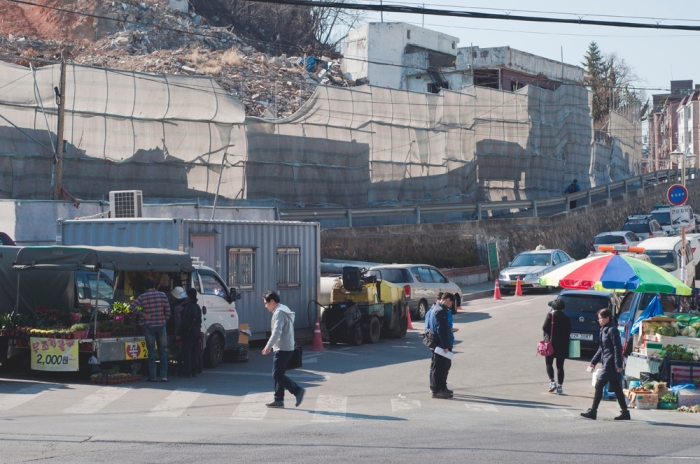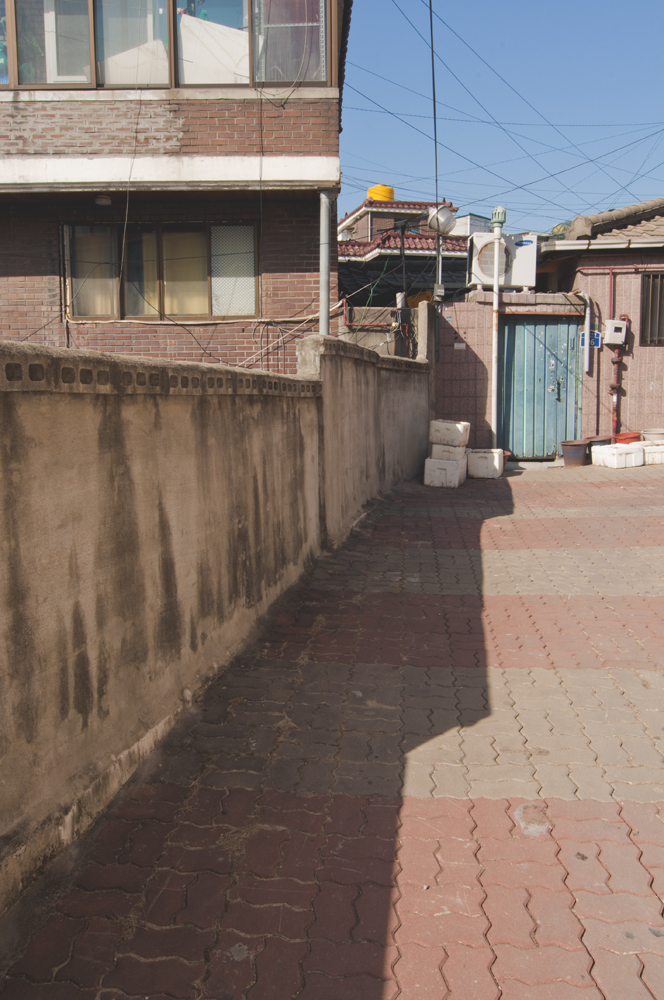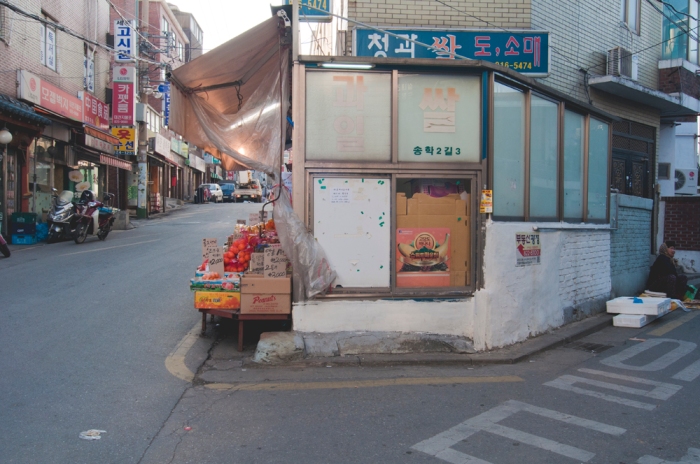Before modernization it wasn’t uncommon to find totem poles marking the entrance to Korean villages, serving as village guardians and frightening away evil spirits. These totems, most often called jangseung (장승), are now mostly found only in folk villages or serving as decorative elements in restaurants, but they once played an important role in Korean life, serving as objects of veneration and expressions of the identity of the villages they stood watch over. One of the most well-known stories related to these objects stems from the latter half of the 18th century, when King Jeongjo, the builder of Hwaseong Fortress, was traveling to Suwon to visit his father’s tomb. His procession stopped to rest in Sangdo, and with no houses around, Jeongjo ordered a pair of jangseung be erected to guarantee safe passage. Since then the area where the totems were erected has been known as Jangseungbaegi.
While jangseung in the southern part of the country were often made out of stone, those in the Gyeonggi and Chungcheong regions were typically wood, meaning, of course, that the original totems are no longer around. Instead, just outside Exit 6 a pair of new Jangseung stands guard next to a small fountain pool. Like many jangseung, these come in a male-female pair. Also like many jangseung, they bear five-character hanja inscriptions, the one on the male, on the left, reading 天下大將軍 (Great General Under Heaven), and the one on the female reading 地下大將軍 (Great General of the Underworld). The faces of the two jangseung are virtually identical, with large eyes and noses and sharp teeth bared in a threatening scowl. A large dot rests between their slanted eyebrows, and at the top of the poles branches had been lopped off, leaving a stubby crown.
The jangseung looked over an area that was in the process of changing, as here and there throughout the neighborhood I would pass blocks or small plots of land that had been razed and surrounded by temporary metal fencing or the familiar green, black, and pink blankets put up around construction sites. There was one just across Jangseungbaegi-ro (장승배기로), a small hill now covered in rubble, with a low wall from a mostly demolished building crowning its top like the ruins of an ancient fortress. Another was south of Sangdo-ro (상도로), on the way to Sangdo Station, where a large area between apartment tower complexes was hidden from view but clearly awaiting the arrival of construction crews. I came across at least two other sites like these in the neighborhood.
While parts of the area were fairly new – especially as one walks toward Sangdo, where the surroundings get nicer and more and more newer buildings and cafes spring up – much of Jangseungbaegi was a bit long in the tooth, and it was those parts that I found more interesting, as I typically do. South down Jangseungbaegi-ro from Exit 1 I followed the road uphill to a point where I could look down on several old or abandoned shops on a parallel street below. Next to them was a home that I at first thought was abandoned – a rope was holding down a blue tarp on its roof and refuse was strewn about its yard behind a stone wall – but when traffic let up I could hear the clinking of silverware coming from inside. On the opposite side of the road, closest to Exit 2, steps led up to a neighborhood of red brick homes crouched around little alleys on a hill.
Outside Exit 3 was a cluster of restaurants and bars and a pair of love motels. There was a garbage and recycling yard, and a bit further on I turned left into Sangdo-ro-22-gil (상도로22길), which had caught my eye with its liveliness relative to the streets around it. Running like a vein through the neighborhood, it was lined with fruit stands and fried chicken joints, bunshiks, butchers, fish vendors, and tofu, banchan, and tteok shops. North of Sangdo-ro, Exit 4 led to another garbage yard and a handful of hostess bars on either side of it, all discreetly closed up in the afternoon.
Two markets also occupy the neighborhood. The first I visited, Yeongdo Market (영도시장), was just past a man selling socks from a table set up outside Exit 1 and down the first side street to the right. On the corner with Sangdo-ro were some vegetable sellers, and perhaps a couple dozen meters past them the market building began, with its old red and white 영도시장 sign half-obscured by a banner hanging in front of it.
Inside it was incredibly quiet, with only a handful of other people walking through the building, though that may have had something to do with it being March 1st, a national holiday commemorating the 1919 reading of the Korean Declaration of Independence in Tapgol Park. There were a couple hair shops, a butcher, a kitchen supplies store, a shoe shop, a banchan shop, a couple of small supermarkets, and a bunshik, outside of which a big pot steamed into the air and I could smell janchiguksu. In the rear of the market was a large area of empty space. Some refuse was scattered on the floor, but it wasn’t dirty so I wasn’t sure if businesses had moved out or just hadn’t moved in yet.
I continued walking through the market building for a bit, passing a sesame oil shop that emitted that salty-sweet smell that I like so much. Above me, wooden beams supported the tin roof, and windows between the roof and the tops of stores let in light, some of which fell on the display of merchandise outside 대흥상회, illuminating an entire wall of ajumma shirts in the gaudiest colors and designs imaginable. Rhinestones, sparkles, clashing colors…it was as if someone had taken the plumages of tropical birds, mixed them in a blender with the pawned throwaways of Studio 54 and a handful of LSD, and run the result through a sewing machine.
The second market was down Jangseungbaegi-ro from Exit 5, though I initially walked right past it. On the station map it’s called Samgeori Market (삼거리시장), while on Naver Maps it’s called New Noryangjin Market (신노량진시장), though if this is the new one I’d hate to see what the old one looks like. The reason I walked past it was because where I expected it to be there were just some dark alleys in a decrepit old building, and I didn’t think that could possibly be the market. It was the market.
I walked over its uneven poured concrete floor, past piles of cardboard, chairs, and other rubbish. Shafts of light streamed through holes in the roof and water dripped down in spots. There was a tiny little electronics shop, a couple tiny restaurants, one place selling dried seaweed and dried fish, another selling bricks of soybean paste. Bare bulbs provided occasional illumination. The upper floors of the building were falling apart; the concrete had disintegrated in several places, revealing rusty metal rebar. In other spots metal poles had been set in place to support the roof. It felt like the entire structure could fall apart at any time, and I hoped the jangseung across the street protected against more than just evil spirits.
Jangseung (장승)
Exit 6
Yeongdo Market (영도시장)
Exit 1
First right after exit
Samgeori Market (삼거리시장) / New Noryangjin Market (신노량진시장)
Exit 5
Left on Jangseungbaegi-ro-19-gil (장승배기로19길) or the alleys after it
























Pingback: SEOUL Weekly: Seoul Selection Guides Set: Seoul & Korea | SEOUL Magazine
Pingback: JANGSEUNGBAEGI.GIF | meagan.in
Pingback: JANGSEUNGBAEGI.JPG | meagan.in
Pingback: Gyeongbokgung Station (경복궁역) Line 3 – Station #327 | Seoul Sub→urban
Pingback: Summer 2 | jal meokgetseumnida